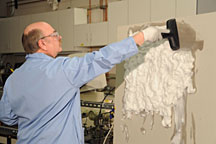- Number 365 |
- June 18, 2012
Gelatin helps foam pull radioactive contaminants from building structures

The Rad Release foam process takes
just a few hours, reduces surface
contaminants by up to 90 percent and
produces a compact waste form.
Researchers looking for a new fix to a stubborn problem have found a solution in good old-fashioned gelatin. The stuff of colorful childhood treats provides the rigidity required for a new type of foam that can stick fast to walls or ceilings.
So why would anyone care about a rigid, gelatin-laced foam? Because the technology can leach radioactive particles or toxic metals from contaminated surfaces more quickly and cheaply than traditional methods.
Radioactive contamination can be difficult to remediate. Removing contamination from complex surfaces such as brick or concrete can be costly, inefficient and hazardous. But the new approach developed at DOE's Idaho National Laboratory is changing that.
The foam can be used alone or in conjunction with a specialized clay to pull contamination off surfaces more effectively than previous methods. The new approach — which minimizes cost, waste volume and worker exposure — has been commercially licensed by Environmental Alternatives, Inc. (EAI), as Rad-Release Chemical Decontamination Technology, or simply Rad-Release.
The Problem
Federal, state, private, and mining sites throughout the U.S. may be contaminated with radiation and toxic metal. Cleaning up building structures at these sites tends to be costly.
That’s partly because radioactivity can be extremely difficult to remove from building surfaces. Radioactive particles can stick strongly to such surfaces or come to rest in hard-to-reach pores and crevices. So for the past 50 years, contaminated materials or structures had to be dismantled and simply buried or isolated in storage. Such methods can be expensive, require significant volumes of storage space and present risks to workers.
Other decontamination approaches are labor intensive, ineffective at removing embedded sub-surface contamination and generate larger volumes of waste. Other agents also can be difficult to use effectively on walls or ceilings since they do not contain a robust foam element.
The Solution
So the INL team set out to make a decontamination agent rigid enough to stick to vertical or inverted surfaces for several hours. Strong acids within the agent dissolve oxide layers while other chemicals act like magnets for radioactivity. To put these properties into a foam, Rick Demmer, an INL chemist and co-inventor of the technology, tried a variety of substances before discovering that gelatin had the right properties.
“Initially we found that when we drove the pH down, it compromised the foam pretty substantially,” he said. “I tried all manner of foam stabilizers, including egg protein and standard chemicals you’d find in soap.”
After borrowing some cherry-flavored gelatin from an INL cafeteria, Demmer discovered that gelatin bestowed the rigidity they’d been striving for. As the foam clings to a contaminated surface, it attracts radioactive particles and traps them within. After 20 minutes to 1 hour, the foam is rinsed and/or vacuumed off the surface for disposal.
When faced with very porous surfaces with deeply embedded sub-surface contamination, a second step can be added utilizing a special clay material to penetrate pores and crevices, pull contaminants from the subsurface over several days or weeks, and reduce contamination by as much as 99 percent.
The clay shrinks by 80 percent after it is removed from the surface and allowed to dry, drastically reducing the final waste volume.
Evidence it Works
So far, Rad-Release has proven itself in real-world laboratory settings, in a side-by-side test sponsored by the EPA, and in both domestic and international competitions.
A side-by-side performance comparison of different decontamination approaches recognized two-step Rad-Release technology as one of the most effective processes. The technique also impressed attendees at two decontamination exercises involving diverse technologies — the EPA’s Liberty RadEx demonstration and an international competition at the Canadian Forces Base in Suffield, Alberta.
R&D Magazine selected Rad-Release for an R&D 100 Award, deeming it one of the most significant inventions to enter the marketplace in 2011. This sort of recognition illustrates how publically funded research can feed commercial innovation while solving both national and international challenges.[Nicole Stricker, 208.526.5955,
nicole.stricker@inl.gov]
